As writers, we often get consumed with making every word perfect. But what if we let go a little bit and wrote more like spoken language? By adding rhythm to our writing, we can create pieces that are easier for readers to follow and more engaging overall. This guide will show you how to write more rhythmic prose.
The benefits of writing with rhythm
Writing with rhythm can be highly beneficial for both experienced and novice writers. For experienced writers, it can help to add variety and interest to their work. It can be a helpful way for novice writers to get started on a writing project.
By writing with rhythm, writers can create a sense of flow and energy that can be very motivating. In addition, rhythm can also help create a more lyrical and poetic writing style.
Finally, writing with rhythm can simply be enjoyable, making the writing process more enjoyable overall. When used effectively, rhythm can be a powerful tool for writers of all levels of experience.
Others have read: 15 Memoir Writing Tips for Beginners: Secrets to a Bestseller
How to add more rhythm to your writing
One of the best ways to add more rhythm to your writing is to incorporate the use of literary devices such as meter and rhyme. Meter is the regular beat created by the arrangement of syllables in a line of poetry, and it can give your writing a musical quality that is very pleasing to the ear.
On the other hand, a Rhyme is the repetition of similar sounds, typically at the end of lines of verse. By using both meter and rhyme in your writing, you can create a strong sense of rhythm that will help to engage your readers.
In addition, another great way to add more rhythm to your writing is to vary your sentence structure simply. Rather than always starting with simple subject-verb-object construction, try using a variety of different grammatical forms to add interest and variety.
By taking these steps, you can infuse your writing with more rhythms and cadences that will really resonate with your readers.
You might also like: How to Write a Fairy Tale
Tips for How to Write More Rhythmic Prose
Writing is like music. It should have a rhythm that is pleasing to the ear. Here are some tips for making your writing more rhythmic:
1. Vary the length of your sentences. A mix of short and long sentences will create a more interesting rhythm than a series of similar-length sentences.
2. Use parallelism. This is when you use similar grammatical structures in successive phrases or clauses. For example, “I like to read, write, and sing.” Parallelism creates a pleasing pattern that can make your writing more musical.
3. Pay attention to the sounds of words. Certain combinations of sounds are more pleasing to the ear than others. To create a more musical sentence, try to use words with similar sounds next to each other. For example, “The bees buzzed around the brightly blooming flowers.”
4. Use alliteration. This is when you use the same sound at the beginning of several words in succession. Alliteration can be used sparingly to add interest and rhythm to your writing. For example, “Sally sells seashells by the seashore.”
5. Be aware of the flow of your words. The way you arrange your words can have a big impact on the rhythm of your writing. Be sure to arrange your words to create a smooth, natural flow.
By following these tips, you can add more rhythm to your writing and create pieces that are more musical and enjoyable to read.
Also popular: 5 Writing Tips to Help Your Articles Go Viral
Examples of rhythmic writing
“I Know Why the Caged Bird Sings” is a beautiful poem written by Maya Angelou. The poem is about the struggles of a young black girl growing up in the South during the time of racial segregation. However, despite the hardships she faced, the young girl remains hopeful and full of potential.
The poem is written in a very rhythmic and musical style, which helps convey the speaker’s emotions. The following are some examples of lines from the poem:
“I know why the caged bird sings, Ah me, When his wing is bruised and his breast is sore,-When he beats his bars and would be free; It is not a carol of joy or glee, But a prayer that he sends up-yonder-star, While from prison walls he looks at thee.”
Another example of rhythmic writing can be found in the works of Langston Hughes. Hughes was a famous poet, novelist, and playwright known for his use of jazz rhythms in his writing. The following words are an excerpt from one of his poems, “The Negro Speaks of Rivers“:
“I’ve known rivers:
I’ve known rivers ancient as the world and older than the flow of human blood in human veins.
My soul has grown deep like the rivers.”
As you can see, both Maya Angelou and Langston Hughes use rhythm to create beautiful, musical works of art. Using rhythm in your writing can infuse your words with emotion and power.
Ways to practice rhythmic writing
Writing is like music. There are different ways to create rhythm in your writing, just like there are various ways to make rhythm in music. You can use repetition, beats, and even pauses to create rhythm in your writing.
Just like with music, the rhythm you create in your writing can affect the way your reader feels while they are reading. It can also make your writing more enjoyable to read. Here are some ways you can practice rhythmic writing:
-Repetition: Repeating words or phrases is a great way to create rhythm in your writing. You can repeat individual words, entire phrases, or even whole sentences. Repeating words or phrases can also help to emphasize important points or ideas.
-Beats: Beats are a type of repetition, but they involve repeating words or phrases with a specific pattern or cadence. This can be done by using metrical feet, such as iambs or trochees, or simply stressing certain syllables more than others.
-Pauses: Pauses are another way to create rhythm in your writing. You can use commas, periods, and other punctuation marks to create pauses of different lengths. You can also use white space on the page to create longer
Final thoughts
Rhythm is an important part of writing. It can help to convey emotion, create a musical quality, and make your writing more enjoyable to read. By using repetition, beats, and pauses, you can create rhythm in your writing. So don’t be nervous about mixing it up, and try different ways of creating rhythm in your writing. Practice makes perfect!










